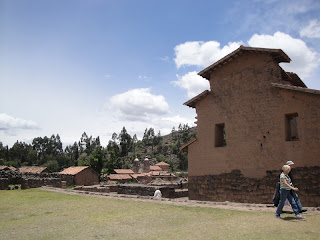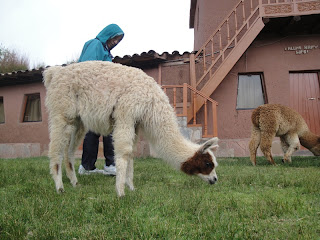Wake-up call at 6 am, bags out at 7 am. We leave at 7:30 am.
Sheila calls it the Pilgrimage Journey from Cusco to Puno !!!!!
(from our Odyssey itinerary:) Early this morning we depart for the day-long journey by coach to Puno, on the shores of Lake Titicaca. As we travel through the rugged snow-capped Andes dotted with small vi llages and herds of llama and alpacas, we make several stops along the way.
We assemble in our hotel Libertador Cusco and then (because of its location in the old city center) are transported with two smaller buses to a big bus.
First stop (but we don't leave the bus) is a little village very close to Cusco were bakeries are famous for baking the bread for Cusco. She tells us that one young baker recently received a coveted international award in France for his bread.
Sheila must have called ahead because a young women brings a bag with two big round loaves to the bus.
Sheila passes the bread around in the bus for us to taste. It is kind of a sweet bread. The breads have a design in the middle. I had seen a stand with bread like it with very elaborate designs on our way back to the hotel from the square but it was raining and the woman was packing up so I did not have a chance to really see it.
After a while the bus driver turns onto a dirt road and we reach Andahuaylillas, an attractive village known for its lovely 17th-century church. No photos allowed inside the Church of San Pedro. I found some lovely photos on this site: click here.

Of course like every where else, there were some craft stands.

I bought some lovely necklaces from the mother of this little one. Taken apart, the beads will make some lovely dividers for lacemakers.
We drove a long way. Pictures out of the moving bus are not so good but still nice memories.
Another stop was to look at the ruins at Raqchi, once the holiest site in the Incan empire. This is the little village square.
Next to the entrance were the vendors. It was not good to pass them before seeing the ruins because some of the group got "hung up" and had to be "retrieved" by Sheila.
Selling booklets about the ruins. The costumes are not just for the tourists. It is what the people wear around the villages and towns.
Totally different Inca building site than we have seen before. If you want more information click here.
Sheila is explaining and showing us a drawing of what the temple might have looked like. The experts of course have to make educated guesses, but slowly they are putting together the puzzle. The Incas did not have any written reports but some exist from Spaniards before they destroyed many of the sites.
Growing between the lava stones. Some said it looks like the California poppy ...
The storehouses. There are 156 of them.
Amazingly nice and cool.
... somebody said it is the Peruvian poison ivy.
Part of the temple site with the village church in the back ground.
This is part of the Inca Trail or better we should say Inca road system. For good information look here.
It is not just a trampled path but a real road paved with stone and fixed on both sides ... for several thousand miles.
We have walked on the Inca Trail even if it was only for a few steps.

Afterwards we had time for some shopping. James and I bought a vase which is in character similar to two we already have. It has lovely colors and is adorned with very meaningful symbols like Pacha mama (mother earth).
Sheila said to meet here again: by the red Inca cross.
A pet falcon on a balcony. I took a photo and was asked for "un soles". Jim from the group and I laughed afterwards wondering whether the man asking us really was the owner or an opportunist.
Photo from the moving bus.
The next stop for a lunch buffet. This was on the floor in front of the banos: Senors and Senoritas (so we know where to go).
This lunch buffet was the last meal before James got really sick. And we tried to be careful with what we ate. Well, you never know. James blames this because several other people from our group got sick at the same time too.
Perched on Peru's altiplano (high plain) is the home to the Llama and Alpaca Research Center.
These are the rare vicuñas.
The guanacos and the vicuñas are the wild ancestors from which the llamas and alpacas evolved and got domesticated. For more information click here.
We also learned that alpacas have shorter necks but that is sometimes difficult to tell when they are still babies. Another difference is that alpacas' tails are down and llama's tails are up. James and I decided to remember "llamas lift".
And then there are short hair and long haired llamas and short hair and long haired alpacas.
La Raya is the line dividing the regions of Cusco and Puno in Peru. At 14222 feet (4335 meters) above sea level, La Raya provides beautiful views of the Andes rising high above alpaca farms.
It is marked on the road and we stop. Of course there are vendors. James and I actually buy a sweater each but mine unfortunately does not fit. It was too cold to try it on there.
We had another potty stop. You are always supposed to pay "un soles". This time we went through the shop into the back yard but since there were only two down there we were sent upstairs. There were two bedrooms through which we had to go.
Sheila told us that this was the area were recently a farmer had received a "world's best"medal for his organic coffee. It was only sold there so we bought some. It was expensive though.
We reach our hotel Libertador Puno on the shores of Esteves Island on Lake Titicaca just when the sun is going down; it's just five minutes into the center of Puno from our hotel.








































No comments:
Post a Comment